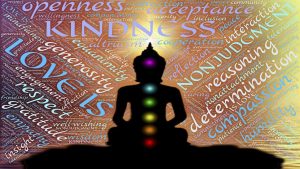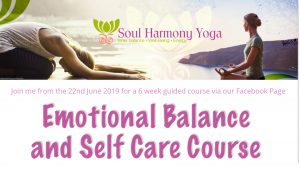In this blog we explore Healing Emotional Trauma with Yoga. It is part of a series of blogs to discuss five Holistic ways of Living to improve our general health. I have added the links to the three previous blogs below.
In yoga releasing emotions and tension from the body is a key part of all classes. In our lower body, particularly around the intercostal muscles and lower chakras, we sometimes hold a lot of our past fear, trauma and emotions that we may not have fully processed. It is often easier to move emotion out of our bodies with movement and then use breath and meditation to truly release and move into a peaceful space.
When practising in this way I strongly encourage a gentle and compassionate approach to self. Using affirmations such as ‘I love and accept myself’ are particularly useful as we become aware of and explore trauma in the body. It is also worth noting that if the trauma is particularly significant that you may need some support to guide you through this such as an experienced yoga teacher or counsellor.
By being present in our practice and gently inviting awareness to our physical body, breath and emotions and a feeling of shifting energy as they arise in our practice, we can allow our emotions to be released. If you have a strong emotional reaction in a yoga session please do take some time for yourself afterwards to ground and feel centred. Journalling about your experience or taking time to rest can be helpful.

Balancing our emotional body with mindfulness meditation
Mindfulness Meditation is also very useful to help release and process emotions and past trauma. For over 20 years Yoga has been a way for me, to come back into my body and balance my emotions and nervous system. Without knowing this is what I was doing for many years, I now realise as a teacher how Yoga can help balance the emotions and gently release past trauma.
Through Yoga (and many other modalities) we can change and redirect our emotions. We refer to our emotions in Yoga as our ’emotional body’. Initially students may start by acknowledging that this ‘body’ exists within and that we can stand outside of it and compassionately observe without judgement (when possible) knowing that it changes all of the time.
That it can have a huge influence on how we are and how aware and mindful we can be in any given moment. A huge part of this is around how Yoga influences the nervous system. Put simply, Yoga and meditation stimulate our parasympathetic nervous system which floods the body with a sense of peace and balance (and some complicated chemical processes from a scientific point of view).
Our Mindfulness Meditation will help you to become aware of emotions and thoughts and allow you to become an observer. Practice over time you will notice space in your life where you may simply have reacted before.

Through Yoga (and many other modalities) we can change and redirect our emotions. We refer to our emotions in Yoga as our ’emotional body’. Initially students may start by acknowledging that this ‘body’ exists within and that we can stand outside of it and compassionately observe without judgement (when possible) knowing that it changes all of the time.
That it can have a huge influence on how we are and how aware and mindful we can be in any given moment.
Here are the links for the previous two blogs in this series ‘Mindful living: 7 holistic ways to achieve it’.
Blog 1 – Mindful living: 7 holistic ways to achieve it
Blog 2 – The Benefits of Pranayama (Breathing in Yoga)
Blog 3- How Having a Grounding Yoga Intention Affects our Practice
Join my next Live Round of Teaching which starts on the 22nd June 2019. I will be guiding your weekly Yoga practice based on our Emotional Balance and Self Care Course.

We have 15 lessons in our Yoga for Emotional Balance and Self Care Online Course. Each lesson covers a specific aspect of how your yoga practice can support your emotional health including:
- Balancing your nervous system,
- Letting go of emotions and resistance to letting go,
- Using your yoga practice as a deep self-care process,
- Developing your confidence
- Specific pranayama, meditation, and relaxations.
- Each individual class has details of the benefits to you for practicing the class.
I’m happy to reply to any questions you may have and have a chat about your own home yoga practice. My email is debs@soulharmonyyoga.org
Until then happy yoga journeying and I wish you all the best.
Namaste,
Debs

